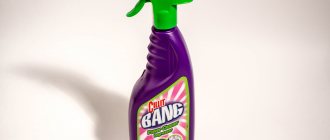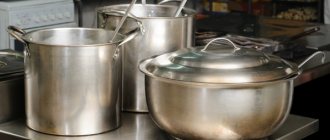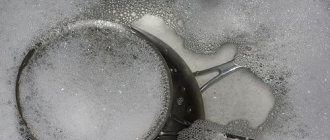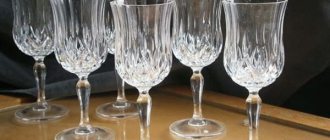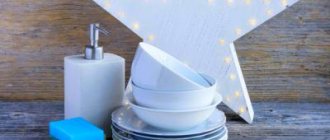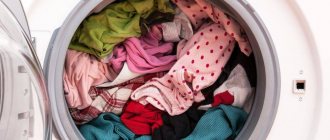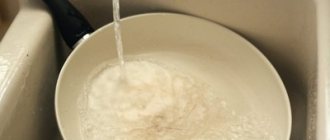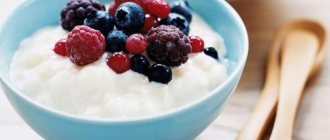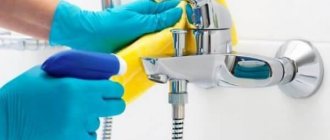How and with what to clean aluminum
Aluminum is a lightweight, durable metal that heats up quickly and evenly. These qualities make it suitable for the manufacture of kitchen utensils, primarily pots and pans, and colanders.
However, initially shiny or evenly matte aluminum household items lose their attractive appearance, becoming covered with oxide, stains, a hard-to-remove coating, or burning to blackness.
It is unpleasant and even dangerous to use such utensils for cooking. Therefore, it is recommended to figure out how to clean aluminum utensils and rid them of carbon deposits and oxides.
Choice of product
The disadvantages of aluminum include the softness of the metal and its instability to abrasive influences. If you plan to keep your pans shiny for longer, avoid using wire wool, brushes, abrasive sponges, or sandpaper.
Even the use of a melamine sponge, which can rid the metal of the oxidation film, will affect the appearance of the utensils - the shiny surface will become dull due to numerous micro-scratches.
Polishing with GOI paste will help return it to ideal condition - rub a rag soaked in a solvent with a piece of hard paste, and then polish the metal surface to a mirror shine.
When choosing how to clean aluminum, you should pay attention to substances that are almost always at hand for any housewife. These include:
- laundry soap;
- baking soda;
- salt;
- table vinegar;
- lemon juice or citric acid;
- dairy products;
- cream of tartar;
- office glue;
- oxalic acid, etc.
When cleaning aluminum utensils from blackness, stains and carbon film, use brushes with semi-rigid polymer bristles, foam sponges, cotton or microfiber napkins, and rags.
If advice on how to clean a burnt pot or frying pan at home does not help you cope with the task, you can try using special products for cleaning porcelain and glass. Or resort to such means as “Chister”, “Bagi Shumanit”, “Oven Cleaner”, etc. Use special equipment according to the manufacturer's instructions.
New aluminum utensils shine attractively, but after some time of regular use they become dull and become covered with unsightly stains. Usually, housewives use the same usual composition for washing aluminum dishes as for pots and pans made of other materials, primarily stainless steel.
But this is the wrong approach. Conventional dishwashing detergents can clean the aluminum surface of ordinary contaminants, but they will not save you from oxidation and will not be able to completely protect you from the gradual formation of plaque, which, under regular exposure to high temperatures, turns into carbon deposits over time.
Therefore, as necessary, including if food is accidentally burnt during cooking, effective cleaning methods for aluminum cookware should be used, using homemade or special products.
Methods for cleaning aluminum from stains and oxides
Option 1. Acidic liquid. Plaque and dark spots can be removed by pouring kefir or sour milk, cucumber pickle, Coca-Cola onto the bottom of the dish and leaving it for 10-12 hours.
The sides of the pan can be wrapped in rags soaked in the appropriate composition and moistened with it several times, preventing it from drying out. After soaking, wash the utensils under running cool water and wipe off dirt with a soft cloth.
Option 2. Sour apples. Wipe the surface of aluminum cookware with sliced apples if they have darkened over time. After waiting about an hour, you can repeat the procedure. Then the dishes are washed and wiped with a rag or soft sponge.
Option 3. How to clean aluminum until it shines using table salt. If the pan turns black, place it in a solution of table salt at room temperature for half an hour or an hour.
To prepare the solution, use warm water and salt in a 1:1 ratio; it is important to wait until it is completely dissolved. After soaking with a sponge, clean the surface until shiny, then rinse with cool water.
Option 4. Cream of tartar. This is a classic method that has been used since the times when aluminum cookware just began to come into everyday use. Tartar forms at the bottom of containers in which wine is stored for a long time.
This precipitate is collected and dissolved in hot water. After the solution has cooled, a soft rag or napkin is well moistened in it, after which an aluminum object with traces of darkening and oxide is treated.
To polish the dishes to a mirror shine, prepare a thick paste from cream of tartar and water. Polishing will take a lot of time and require some effort.
Then the utensils are washed in cool water and wiped dry with a soft cloth. Cleaning with cream of tartar is considered more gentle compared to using citric acid or vinegar or exposure to high temperatures during boiling.
Option 5. Soda. Sodium bicarbonate is poured into a small bowl or other suitable container, a little water is added until a slurry forms. The resulting composition is applied to the darkened surface of the pan and rubbed with a soft cloth. After polishing, rinse the dishes thoroughly.
Option 6. Soap solution + polishing. Laundry soap shavings are dissolved in hot water, and utensils are soaked in it. Then they are washed and treated until shiny with a sponge using a mixture of ammonia (5 grams) and borax (15 grams).
Cleaning aluminum from corrosion and oxide
Let's look at how to clean aluminum and products made from it from oxidation, soot, plaque and other contaminants. Cucumber pickle, milk and kefir will be effective in the fight against dark spots. Choose the product you have and fill the bottom with it, leave it like that for 12 hours. Rinse thoroughly with cold running water. Now it will be easy to wash off all the dark spots with a simple cloth.
Cleaning the soot is even easier; just take a sour apple and cut it in half. We rub the surface with half, thanks to the acid you will quickly remove all the carbon deposits.
Cleaning and polishing aluminum from oxide occurs as follows. Take regular salt and hot water, dilute in equal proportions. The water can be of any temperature, the main thing is that the salt dissolves without problems. Apply a solution at room temperature to the required surface and leave for a little time. Now you can use a sponge to clean the aluminum until it shines.
See also video:
Glue and soda
You can make a strong remedy against carbon deposits with your own hands. To do this you will need office glue, soda and water. Take a bowl, pour 10 liters of hot water into it and add 100 grams of soda and glue. Now we immerse the desired item in the solution for 3 hours. This is enough for the required reaction to take place. To completely remove dirt and clean it to a mirror, work thoroughly with a sponge. Pour everything out and rinse with clean water, wipe and leave until completely dry.
Table vinegar
This method is especially successful in cleaning aluminum coins. The method itself is not complicated and requires very little time. Take apple or table vinegar and moisten a regular napkin or soft cloth in it. Now you can easily wipe off all dirt.
If you need to clean the dishes, pour vinegar into it and put it on the fire until it boils. Now remove from the heat source and leave to cool. When the liquid reaches room temperature, begin washing. In the case of other items, you can immerse them in a container where vinegar will be boiled and do the same with it. Boil the polished item in clean water and rinse thoroughly.
Cream of tartar
When the question arises: how to clean aluminum? You can resort to non-standard means, one of which is cream of tartar. Few people know that with its help you can cope with darkening and plaque on metal. To do this, pour hot water into a bowl and dissolve the stone in it, add lemon juice and bring it all to a boil. Now let it cool, then generously moisten a soft cloth in it and wipe the desired item from all sides.
You can also dissolve cream of tartar in water to form a thick mixture. It is used to rub the dirty surface to a mirror shine. Of course, you have to try hard to achieve this effect. Wash in water to remove residues and wipe dry. In this case, there are no effects of high temperature and citric acid, so the effect will not be as strong. But the method is more gentle.
Soap solution
Anodized aluminum can be polished using a soap solution. Some people know this method, but let’s resume our knowledge and tell you how to clean using this method. This type of metal can only be cleaned with soapy water, as it is the most delicate cleaning agent. To get it, just dissolve soap shavings in water, now you need to wash the product with it. This way you can clean off dirt, but not to the point of being new. For shine, you need to use a different solution: 5 g of ammonia and 15 g of borax are mixed and the surface is rubbed with a sponge, after which it is washed generously with water.
Baking soda
For those who have not yet decided what they will wash with, we offer the last, but no less effective method using soda. The recipe is simple: add enough water to the baking soda to form a paste. Now we apply it to the metal surface and wipe it well. After this, it is recommended to thoroughly rinse off all residues with clean water. This way you can clean and polish aluminum.
Read also: Casting aluminum into the ground
Aluminum is a fairly light and durable metal, and therefore is often used in the kitchen as the main material from which cookware is made. When plaque appears, it becomes unpleasant to cook in it, and it is impossible for safety reasons, and therefore the question arises of how to clean aluminum until it shines.
Methods for removing carbon deposits
Layered carbon deposits on the outside of the frying pan or food residues on the bottom that have burned and firmly stuck to the metal surface cannot be removed using the methods described above. Let's look at powerful cleaning methods.
Option 1. Soda + glue. Pots or pans made of aluminum, on the walls of which carbon deposits have formed, are soaked for 3-4 hours in a solution made from baking soda, office glue and water.
Ten liters of hot water are poured into a container of suitable size, then one hundred grams of soda and silicate glue are dissolved in it. Utensils soaked in a cooled solution are cleaned with a sponge until shiny and thoroughly rinsed in clean water.
Option 2. Table vinegar. If you do not have special tools at your disposal that can effectively clean a burnt aluminum pan, use regular table or apple cider vinegar (6 or 9%), you can also dilute the essence in a ratio of 1 part to 10 parts water.
General recommendations
Aluminum is a soft metal that requires careful handling during operation and cleaning. To clean products from various types of contaminants and not damage the material, follow simple recommendations:
- Do not use metal scrapers or brushes, hard scourers or sharp objects . These tools damage the surface, leaving scratches and other unsightly marks. After such treatment of the dishes, aluminum particles can get into the food, which will negatively affect the taste of the dish and its benefits.
- Do not clean aluminum alloy products with abrasive agents (sand, powder).
- Kitchen utensils should be washed only after they have cooled down . Hot metal deforms when interacting with water, and it is almost impossible to return its original appearance on your own.
- such as acids or alkalis for cleaning They spoil the aesthetic appearance, and the resulting chemical reaction can lead to the release of toxins or heavy metals that are hazardous to health.
- To achieve the desired effect, choose a cleaning method and cleaning product based on the type and degree of contamination .
- Do not wash aluminum cookware in the dishwasher . Temperature changes negatively affect the metal and increase the risk of deformation and corrosion.
- To make the product shiny, polish the surface with a sponge dipped in a solution made from borax and ammonia in a ratio of 3:1.
How to clean aluminum oxide at home
Aluminum is susceptible to oxidation. As the product is used, the oxide layer grows, which leads to the appearance of dark spots that cover the entire surface or individual parts.
You can clean oxide and blackness at home using available folk remedies :
- Soda . Dissolve the product in a small amount of water to obtain a paste. Apply the mixture to the stain and work the surface in a circular motion.
- "Coca Cola" . Fill the item with soda and after 1.5 hours wash it with water.
- Sorrel . Place a bunch of fresh sorrel in a container that needs cleaning and fill it with water. Place the dishes on the stove and boil the mixture over low heat for 30 minutes. Drain the solution and rinse the product.
- Lemon acid . In a saucepan, combine 2 tbsp. l. citric acid and 1 liter of water. Boil the solution for 15-25 minutes, depending on the degree of contamination, and then wash the container with clean water.
- Apple . Rub the darkened, oxidized mark with half the fruit and leave for half an hour for the malic acid to take effect. After the time has passed, wash the container with detergent.
Mustard powder, vinegar and salt
To remove blackness from the outer walls of the product, prepare a mixture of equal parts of table salt, vinegar and dry mustard powder. Mix the ingredients until smooth. Using a sponge, apply the mixture to the stains and after 15 minutes, rinse with warm water.
Salt
To clean aluminum, combine 2 tbsp. l. salt and 1 tsp. warm water. Mix the ingredients and apply to a sponge. Rub the mixture into the stained area, leave for half an hour, and then wash the pan.
To clean aluminum products, use products containing natural acids: kefir, lemon juice, yogurt, cucumber pickle. Fill the container or part with the selected product and leave overnight. In the morning, rinse the product and wipe dry.
Cleansers based on oxalic acid will help get rid of significant blackening. Apply the drug to the surface, wait the time indicated on the package, and then rinse with water.
Cream of tartar
You can remove dark spots using cream of tartar. To clean, dissolve 3 tbsp in 5 liters of warm water. l. product and soak the product in the resulting solution for 2-3 hours. Remove any remaining dirt with a soft sponge, rinse with warm water and wipe dry.
Paste GOI
If you try to remove small ones, the result will be the opposite: the screen will look dirty, dull, and covered with shiny dimples.
So, GOI pasta. It was developed specifically for polishing and grinding various surfaces back at the Soviet State Optical Institute (hence the name). You can find it in almost every optical store, and it is inexpensive. So, armed with such a block and everything necessary, we can begin the polishing process.
- Apply a drop of machine oil to the glass, then take a small piece of paste and begin to lightly rub the surface with a fiber cloth.
Let’s make a reservation right away: this process is not the fastest, because polishing the screen takes from 40 to 60 minutes (depending on the depth of the scratches and effort).
- You need to rub until you see that there is no oil or paste left.
- Then we add more and continue polishing until we see the result.
- At the end of the procedure, take a regular screen polish, a clean cloth, and continue cleaning the glass (2-3 minutes is enough).
If you put a protective film on your phone screen, but scratches appear on the body, then this method can also be used.
Methods for removing carbon deposits from aluminum
Carbon deposits are a common phenomenon for aluminum cookware. Removing the remains of burnt food and returning the product to its natural shine and cleanliness is quite difficult, given the softness and capriciousness of the metal. However, it is possible to cope with the problem using available means and small tricks.
Dentifrice
To remove carbon deposits from the bottom of the pan, sprinkle it generously with tooth powder and sprinkle with a little water. Leave the container like this overnight, and in the morning remove dirt with a silicone spatula or soft sponge.
Laundry soap and vinegar
To clean carbon deposits, use the following effective method:
- Prepare a large enamel pan that will freely accommodate the container that needs cleaning.
- Pour 1.5 liters of water into the bowl, add grated laundry soap and 150 ml of table vinegar.
- Close the container with a lid and boil the product to be cleaned for 30 minutes.
- Wash aluminum cookware with a mild soap solution and then rinse thoroughly.
PVA and soap
Method for removing serious contaminants:
- Boil 3 liters of water in a saucepan.
- Add 1 tbsp. l. PVA glue and a third of a bar of bath soap, cut into thin slices.
- Boil the solution under a closed lid for 30-40 minutes.
- Wash the pan with detergent and rinse well with running water.
Remove carbon deposits
Cleaning oxides and carbon deposits is also quite simple. This will require funds and products that many people have in their homes. Moreover, such cleaning does not take much time and does not require serious effort.
- Aluminum is clarified using brine from cucumbers, fermented milk products such as milk and kefir. It is necessary to pour the available product into the dishes that need to be cleaned for half a day. Most often they leave it overnight so that you can simply wash the dishes in the morning. If you need to clean some objects from carbon deposits, they can be placed at the bottom of the container that was filled. Cleansing occurs thanks to the acids found in these products.
- A sour apple will help clear carbon deposits and remove oxidation. The fruit needs to be cut in half and rubbed onto the desired surface until shiny. The acid will corrode all dirt, and therefore, after rinsing with water, the item will shine.
- Contaminants can be removed using a saline solution. You need to take salt and water in equal proportions, and the first ingredient should be completely dissolved. Using a sponge, you need to apply the solution to the item that requires cleaning, leave it in this state for a while, and then rinse thoroughly with water.
Read also: Jrm a55 what is it
Methods for removing scale from aluminum cookware
Aluminum cookware is susceptible to scale formation. This is due to the high content of heavy metal salts and lime deposits in tap water. To fix the problem and return the kettle, saucepan or can to shine and cleanliness, you need to properly clean and wash the products in a timely manner.
Algorithm for cleaning an aluminum kettle:
- Pour 1/2 bottle of vinegar, 9%, into the container.
- Close the kettle with a lid and boil.
- After boiling, shake the liquid to coat all sides of the dish.
- Drain the solution, add clean water and boil the kettle twice.
To get rid of the unpleasant vinegar aroma after cleaning, place an orange/lemon peel in a bowl, cover with water and leave for 15 minutes. This trick will create a pleasant aroma and freshness.
Lemon acid
Instructions for descaling aluminum:
- Dissolve 25 g of citric acid in warm water (1.5 l).
- Pour the solution into the container, close the lid and put on fire.
- After boiling, boil the liquid for 5 minutes with the lid open.
- Leave the dishes to cool completely.
- Rinse the product with running water.
How to properly clean aluminum cookware?
As mentioned above, aluminum cookware stands out for its light weight. In addition, heating occurs evenly and does not require a large consumption of a heat source. New products sparkle, but over time, if not properly cared for, they become dull and oxidize. The vast majority of women use the same products to clean aluminum as they use for other cookware. This is a common misconception; detergents will not restore beauty and shine, but will only wash away grease and external dirt.
To clean aluminum, just follow these simple recommendations:
- You should start washing aluminum cookware only after it has completely cooled down. Don't rush, otherwise you may do harm. Dipping hot metal into water can cause it to deform and completely ruin the product.
- The real problem is the burnt food on the bottom. In the fight against this, even knives and iron brushes are used, which leave their marks forever. And everything can be done without sacrifice. To do this, just pour warm water and add detergent. Stir and leave for 30 minutes. Now, using a regular cloth, you can easily clean off the burnt residue.
- Despite all the advantages of aluminum, it also has a significant disadvantage. You need to wash it by hand, as the dishwasher uses hot water, which can cause deformation.
- It is better to wash without using strong acids, they will not return the former shine.
- When washing, do not use metal or hard brushes, which leave their mark on the surface.
Read also: Connection diagram for 220V compressor electric motor
Rules for using aluminum cookware
Every housewife can preserve the original appearance of kitchen utensils, protect them from deformation and serious contamination. To do this, follow the basic recommendations for the operation and care of aluminum products:
- Do not use dishes for pickling cucumbers, cabbage and other products. The acid reacts with the metal, which provokes the release of toxic substances that are hazardous to health.
- Aluminum utensils are not suitable for daily use due to rapid wear.
- Do not store leftover food in aluminum containers.
- Avoid prolonged exposure of metal to high temperatures. Use medium to low heat while cooking.
- For cleaning, do not use powder, sandpaper, or other abrasive tools.
Aluminum products are lightweight, multifunctional, and easy to use. With proper use and care, a kitchen utensil, sink or part will last a long time, fulfilling its main purpose.
To understand the nuances of cleaning aluminum, watch the following videos:
Young mother, wife and part-time freelancer. Being a lawyer by training, I am accustomed to collecting and providing the most complete and reliable information. Constantly improves in the professional field and strives for personal growth and development.
Found a mistake? Select the text with the mouse and click:
Fresh lemon is not only suitable for tea: clean dirt from the surface of an acrylic bath by rubbing with half a cut citrus, or quickly wash the microwave by placing a container of water and lemon slices in it for 8-10 minutes at maximum power. The softened dirt can simply be wiped off with a sponge.
There are special traps to combat moths. The sticky layer with which they are covered contains female pheromones that attract males. By sticking to the trap, they are eliminated from the reproduction process, which leads to a decrease in the moth population.
The habit of using an automatic washing machine “sparingly” can lead to the appearance of an unpleasant odor in it. Washing at temperatures below 60℃ and short rinses allow fungi and bacteria from dirty clothes to remain on internal surfaces and actively multiply.
Threads made of gold and silver, which were used to embroider clothes in the old days, are called gimp. To obtain them, the metal wire was pulled for a long time with pliers to the required fineness. This is where the expression “to drag out the rigmarole” came from - “to do long, monotonous work” or “to delay the completion of a task.”
The easiest way to remove scale and carbon deposits from the soleplate of the iron is with table salt. Pour a thick layer of salt onto the paper, heat the iron to maximum and run the iron over the salt bed several times, applying light pressure.
Before removing various stains from clothing, you need to find out how safe the selected solvent is for the fabric itself. It is applied in a small amount to an inconspicuous area of the item from the inside out for 5-10 minutes. If the material retains its structure and color, you can move on to stains.
If your favorite things show the first signs of gestation in the form of untidy pellets, you can get rid of them using a special machine - a shaver. It quickly and effectively shaves off clumps of fabric fibers and returns things to their proper appearance.
Stretch ceilings made of PVC film can withstand from 70 to 120 liters of water per 1 m2 of their area (depending on the size of the ceiling, the degree of its tension and the quality of the film). So you don’t have to worry about leaks from neighbors above.
The dishwasher cleans more than just plates and cups. You can load it with plastic toys, glass lamp shades and even dirty vegetables, such as potatoes, but only without using detergents.
Polishing aluminum at home
To restore the characteristic shine of an aluminum surface at home, various folk methods and household chemicals are used.
Tools and devices
What you need to have on hand to get rid of scratches and dullness, and restore the original aesthetics of objects: for this, use a special paste for polishing aluminum. You can also deal with the problem using a number of common cleaning products and kitchen products, including:
- soap solution;
- glass and porcelain cleaning products;
- cream of tartar, table vinegar;
- baking soda, salt, lemon, alcohol;
- sorrel, sour apple, kefir.
In addition, you will need the following set of tools for polishing aluminum:
- fine and medium grit sandpaper;
- felt-coated polishing discs;
- metal brush;
- rags.
When choosing products and devices for polishing aluminum products at home, you should take into account the composition and characteristics of the material being processed. Food-grade aluminum should not be polished with abrasives; gentle methods for eliminating defects are appropriate here.
Pre-cleaning
If you plan to work with a painted part, at the initial stage of the procedure it is necessary to carry out preliminary cleaning, remove coating residues and oxidation particles. For this, various solvents and abrasives are used.
Tartar polishing
Cream of tartar solution copes well with darkening and deposits on metal:
- dissolve cream of tartar in a container of hot water, add lemon juice and bring to a boil;
- moisten a soft cloth in the cooled solution and wipe aluminum objects to a mirror shine.
Aluminum polishing can be done with cream of tartar
If cream of tartar is diluted with a small amount of water to a paste-like consistency, you can obtain an effective remedy for soot, oxidation and various contaminants on metal products.
Application of polish
As a special product for the care of aluminum products, polish has a number of advantages:
- helps quickly eliminate scratches and other visual defects;
- allows you to polish the aluminum surface to a mirror shine;
- does not contain ammonia and other aggressive substances;
- forms a protective layer, provides a barrier against oxidation.
Paste for polishing aluminum in Moscow and other regions is presented in a wide variety of products.
The nuances of using polish:
- The surface is pre-cleaned of paint coatings and dirt using a metal brush.
- Alternately, roughness is eliminated using medium and fine grain abrasives.
- After grinding, a paste is applied to the aluminum and rubbed in a circular motion using a rag until it has a reflective effect.
- Remains of the product are removed with a clean napkin.
To increase resistance to minor scratches and dirt, the surface is varnished after polishing.
Traditional methods of cleaning and polishing aluminum products
To give a shiny look to household items and decorative elements, use various recipes with simple and inexpensive ingredients.
Sour apple
To clean the container from carbon deposits, you need to cut the apple in half and rub the surface well with the half. The acid in the fruit helps to quickly remove soot.
Kefir or cucumber pickle
To combat dark spots, leave the dishes with brine or kefir inside for 12 hours. Next, you need to wash the product in warm water with a soft cloth.
Baking soda
Dilute soda with water to a paste consistency, which is applied to the metal and wiped with a sponge. This method will help to clean the product from plaque and dirt, and polish it to a shine.
Baking Soda - Aluminum Polish
Ammonia and borax
A homemade polishing mixture of borax (15 g) and ammonia (5 g) allows you to restore the beauty of the product and give the thing a mirror-like shine. The composition is applied with a sponge and rubbed well, then rinsed under running water.
Professional cleaning products
To clean aluminum until it shines, you can buy special products in the store. Before using them, be sure to study the instructions for use, which are indicated on the label. Some products have a pungent odor; the cleansing procedure should be carried out in a well-ventilated area or with a protective mask.
After cleaning, the dishes should be rinsed well with plenty of water to remove chemicals from their surface.
Among the popular special products for cleaning aluminum are “Shumanit”, “Chister”, Amway, Bref, Losk.
The nuances of polishing aluminum sheet products
Leveling the surface and eliminating scratches on sheet metal is done using a polishing machine. Sequence of work:
- Preparatory stage. The surface is cleaned of paint, dirt and oxide using a metal brush. Use a soft cloth to remove residues and dust deposits;
- Grinding. Medium-grained abrasives correct visual defects, roughness, and deep scratches. Next, using fine sandpaper, level the surfaces to a perfectly smooth state.
The grinding machine allows you to process aluminum to an exceptional shine. The polishing wheel of the device is equipped with various types of attachments depending on the nature of the work and the characteristics of the material.
The nuances of working with a grinding unit:
- the polishing wheel, like the sheet of metal being processed, is moistened with water;
- as a result of friction, heating of the metal plane is observed, under the influence of the rotating circle, roughness is eliminated, small particles of metal and water are formed in the form of a slurry;
- regularly, at intervals of 1-2 minutes, turn off the device, rinse the polishing disc under running water, wash off particles of formations on the metal sheet;
- After leveling visual defects with the help of abrasives, the grinding machine wheel is equipped with a felt attachment and final polishing of the aluminum is performed.
REPAIR OF ANODIZED ALUMINUM PRODUCTS WITH UV RESIN
Materials:
Set with UV polymer “5 seconds”, (UV resin)
https://www.nipg.ru/ru/magazin/uv-lak/nabor-s-uf-polimerom-5-sekund
What is aluminum anodizing?
Corrosive erosion of metal can significantly change the properties and qualities of the metal. There are two participants in this process - water and an electrochemical reaction, and temperature and humidity also affect corrosion.
Aluminum is resistant to corrosion, but it is very sensitive to oxygen, as a result of which it loses its shine and a durable film appears on the surface - aluminum oxide (Al2O3), which is insoluble in water. This film protects aluminum from damage due to humidity, but does not provide protection against corrosion.
Anodizing aluminum is a chemical or electrochemical surface treatment method that prevents oxidation. This treated surface adheres well to the primer.
Unlike the traditional galvanization method, anodizing does not apply a surface layer of another metal. Here, the surface of a light metal part is covered with an oxide layer as a result of anodic oxidation in an electrolyte.
Since the oxide layer is formed from the base material, the increase in size is only 50-55%. The rest penetrates into the base material, resulting in good adhesion to the base. Anodizing layers are hard, corrosion-resistant, wear-resistant and have an electrical and thermal insulating effect.
Suitable for use in all areas where there is a demand for aluminum with increased technical requirements.
Repairing a damaged area of an anodized aluminum product using the example of a bicycle fork.
Aluminum structures with anodization are designed to last much longer than structures without such protection, but not everyone can carry out the anodizing process on their own. Therefore, a very urgent task is to repair the damaged area of an anodized aluminum product. In the event that the damaged area has a small area, and the damaged product itself actively moves relative to another product made of softer materials that can be destroyed by friction, quick and high-quality repair of the area can become an economically more justified procedure compared to updating anodized covering the entire product.
For example, parts of the front suspension fork of an expensive bicycle, called “legs,” are now often made of anodized aluminum. Due to the fact that the “legs” of the front fork actively move inside the so-called “pants” during driving, damage to the anodized surface of the “legs” (scratches, chips, gouges) can very quickly destroy anthers and oil seals made from softer materials, leading to lubricant leaks. Over time, a plug damaged in this way will no longer perform its primary function.
Some repair specialists have found a way out of this situation by using ultraviolet curing resin to eliminate defects on the surface of anodized aluminum. Set with UV polymer “5 seconds”, (UV resin)
https://www.nipg.ru/ru/magazin/uv-lak/nabor-s-uf-polimerom-5-sekund
In order to repair a damaged area of anodized aluminum we will need:
– primer for aluminum, stainless steel and galvanic coatings,
- fine sandpaper,
— Ultraviolet curing resin “5 seconds”,
- a source of ultraviolet light with a wavelength of 365 nm or 395 nm (lamp or flashlight),
- isopropyl alcohol to degrease the surface
Procedure:
1. Thoroughly sand the surface of your aluminum product with fine sandpaper. The less grainy sandpaper you use, the better. Size 600, 800 or 1200 is suitable;
2. Degrease the surface using isopropyl alcohol;
3. After complete cleaning and degreasing, coat the surface as quickly as possible with a primer for aluminum and stainless steel. If you leave aluminum treated with sandpaper in the air for a long time, then after a short time it will begin to darken - this is the result of the oxidation process, and primer does not apply well to oxidized aluminum. This is why it is so important to apply the first coat of primer as soon as possible.
After a few minutes, after the first coat of primer has dried, you need to apply a second coat of primer for better adhesion of the UV resin to your product.
4. Apply a thin layer of UV resin to the area to be repaired. Level it (for example, with a wooden toothpick), remove excess resin.
5. Illuminate the resin with an ultraviolet flashlight for 1-2 minutes. Remove the sticky layer with isopropyl alcohol.
6. For additional protection of the product, you can coat it with a layer of varnish.
If you follow these instructions exactly, the repaired area on an anodized aluminum product will be visually difficult to distinguish from the factory coating. The gel will last for many years, and the product itself will look like new!
Safety requirements:
1. When repairing anodized aluminum, you must work in a well-ventilated area and do not forget about personal protective equipment
2. Repairs must be carried out in a clean and dust-free room.
